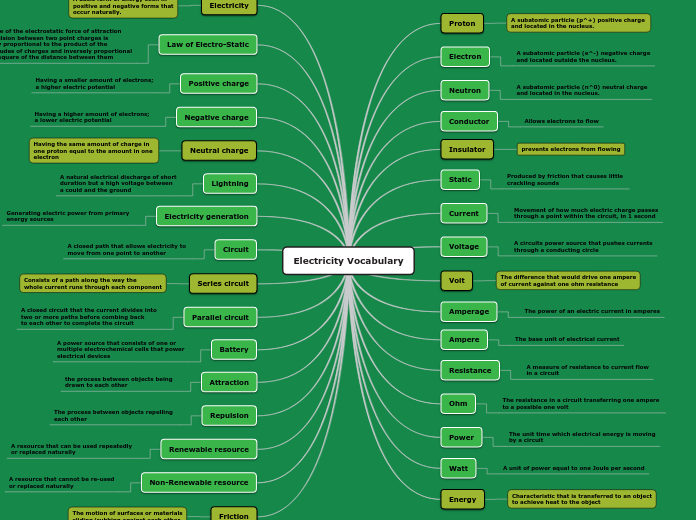Electricity Vocabulary
Proton
A subatomic particle (p^+) positive charge
and located in the nucleus.
Electron
A subatomic particle (e^-) negative charge
and located outside the nucleus.
Neutron
A subatomic particle (n^0) neutral charge
and located in the nucleus.
Conductor
Allows electrons to flow
Insulator
prevents electrons from flowing
Static
Produced by friction that causes little
crackling sounds
Current
Movement of how much electric charge passes
through a point within the circuit, in 1 second
Voltage
A circuits power source that pushes currents
through a conducting circle
Volt
The difference that would drive one ampere
of current against one ohm resistance
Amperage
The power of an electric current in amperes
Ampere
The base unit of electrical current
Resistance
A measure of resistance to current flow
in a circuit
Ohm
The resistance in a circuit transferring one ampere
to a possible one volt
Power
The unit time which electrical energy is moving
by a circuit
Watt
A unit of power equal to one Joule per second
Energy
Characteristic that is transferred to an object
to achieve heat to the object
Electricity
A basic form of energy seen in
positive and negative forms that
occur naturally.
Law of Electro-Static
The size of the electrostatic force of attraction
or repulsion between two point charges is
directly proportional to the product of the
magnitudes of charges and inversely proportional
to the square of the distance between them
Positive charge
Having a smaller amount of electrons;
a higher electric potential
Negative charge
Having a higher amount of electrons;
a lower electric potential
Neutral charge
Having the same amount of charge in
one proton equal to the amount in one
electron
Lightning
A natural electrical discharge of short
duration but a high voltage between
a could and the ground
Electricity generation
Generating electric power from primary
energy sources
Circuit
A closed path that allows electricity to
move from one point to another
Series circuit
Consists of a path along the way the
whole current runs through each component
Parallel circuit
A closed circuit that the current divides into
two or more paths before combing back
to each other to complete the circuit
Battery
A power source that consists of one or
multiple electrochemical cells that power
electrical devices
Attraction
the process between objects being
drawn to each other
Repulsion
The process between objects repelling
each other
Renewable resource
A resource that can be used repeatedly
or replaced naturally
Non-Renewable resource
A resource that cannot be re-used
or replaced naturally
Friction
The motion of surfaces or materials
sliding/rubbing against each other
